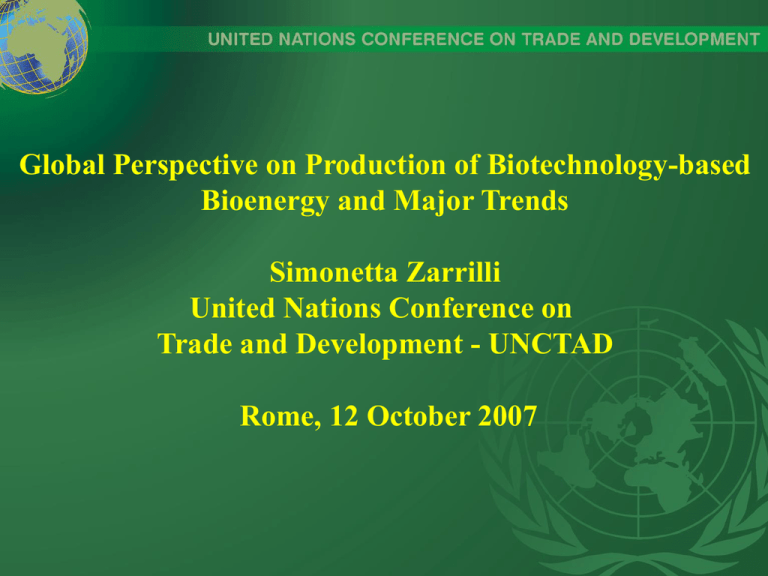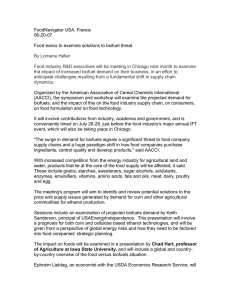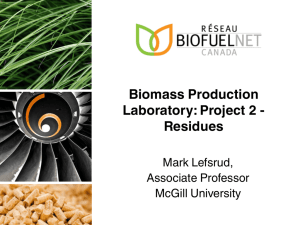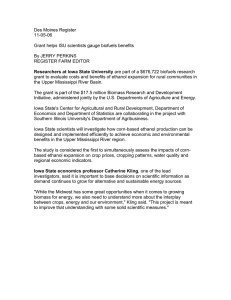Global Perspective on Production of Biotechnology-based Bioenergy and Major Trends Simonetta Zarrilli
advertisement

Global Perspective on Production of Biotechnology-based Bioenergy and Major Trends Simonetta Zarrilli United Nations Conference on Trade and Development - UNCTAD Rome, 12 October 2007 Why Bioenergy? • Economic growth and increasing population will lead to 1.6% p.a. increase in global energy demand between 2006 and 2030 (IEA, 2006) • Increasing fossil fuels cost, energy security concerns and climate change preoccupations have motivated countries to explore alternative energy sources, including bioenergy – energy produced through the processing of biomass (any derived organic matter available on a renewable basis): e.g. biogas, bioethanol, biodiesel • Concerns about high fossil fuels prices and energy security and efforts towards climate change mitigation are expected to feature highly in the international agenda in the years to come. This will keep interest for bioenergy high Bioenergy perspective by 2050 • Bioenergy may satisfy 1/3 of the world’s future energy needs key alternative to fossil fuels • Represents 1-3 trillion US$ market value worldwide • Involves some 10% of the world land surface (Copernicus Institute for Sustainable Development and Innovation Management) Biofuel Classification First Generation (from sugars, grains, or seeds) • Biodiesel – rapeseed, soybeans, sunflowers, jatropha, coconut, palm, recycled cooking oil • Ethanol – From grains or seeds: corn, wheat, potato – From sugar crops: sugar beets, sugarcane Second Generation (from lignocellulose: crop residues, grasses, woody crops) • Biological fuels – Ethanol via enzymatic hydrolysis • Thermochemical fuels (most made via “gasification”) – – – – – Fischer-Tropsch liquids (FTL) Methanol, MTBE, gasoline Dimethyl ether (DME) Mixed alcohols Green diesel First Generation Biofuels • Use of sugar or starch crops creates limitations: – – – – Competition for food uses Plants optimized for food, not energy Only part of the plant is converted to biofuel Co-product sales often important for acceptable economics • Only modest energy and GHG benefits, except with sugarcane ethanol (due to greater utilization of the above-ground biomass) • Can blend with existing petroleum-derived motor fuels – minimal infrastructure change • Large-scale experience in Brazil and USA • Relatively high costs (except sugarcane ethanol in Brazil) due to high feedstock cost • Cost penalties less severe at smaller scales Second Generation Biofuels • Made from lignocellulosic materials – – – Biomass that is generally not edible Larger fraction of the plant is converted to fuel Plants can be bred for energy characteristics (high yield, low inputs) • Two generic processing routes: biological or thermochemical • Can blend with petroleum fuels in most cases • Substantial energy/environment benefits compared with most 1st generation biofuels due primarily to greater biomass usability per unit land area • Greater capital-intensity than 1st generation biofuels, but lower feedstock costs higher cost-scale sensitivity larger scale facilities needed for optimum economics The role of biotechnology Biotechnology is not a source of energy, but a scientific method that provides tools to produce energy •Biotechnology permits the modification/selection of plants to enhance their conversion to fuels •Biotechnology can be used for yield increase, better biomass quality, disease resistance Biotechnology can be used to facilitate the manufacturing process (from biomass to biofuels) Concerns related to environment/biodiversity protection More acceptable for consumers The International Trade Dimension • Biomass & biofuel trade has been limited in the past as most of the production has been for domestic consumption • Several countries will not be in a position to produce enough biofuels to satisfy their demand; some countries/regions are endowed with conditions which allow them to produce biofuels and feedstock competitively production& international trade are expected to escalate rapidly to satisfy increasing worldwide demand concerns about the sustainability of biofuels development Flows of ethanol in 2000 (thousand tons) Flows of ethanol in 2004 (thousand tons) Total trade of ethanol: 3 billion liters (2004) Total production of ethanol: 51 billion liters (2006) Biofuels Certification Initiatives • National governments and regional groupings: Belgium, the Netherlands, UK, Brazil, Canada, Germany, US-California, European Commission • Companies: e.g. Electrabel, Essent • NGOs: e.g. WWF • International Bodies and Initiatives • International Networks and Roundtables: e.g. RSPO, RSPEPFL What for? Ensuring that biofuels/biomass production contribute to climate change mitigation, improved energy security and rural development, without having detrimental side-effects on food security, land use, environmental protection, labour conditions, etc. Specific concerns related to biotechnology • Several certification systems do not allow the use of GMOs. These are for example FSC for forest and all certification systems for ecological agriculture • EurepGAP certification program: (i) Planting of any GMO must comply with all existing regulations in the countries of production and consumption (ii) The use of GMO cultivars must be agreed with individual customers prior to planting; (iii) Suppliers must inform all customers of any developments relating to the use of products derived from genetic modification before engagement • Cramer report: no indicator has been included for GMOs. The views with regard to GMOs are divided and the discussion about this lies beyond the field of activity of the project group Why is certification important? • Market access and market acceptability • Only certified biofuels may count towards biofuel blending targets • Only certified biofuels may benefit from tax breaks and other incentives WTO Implications • The “Like products” issue • “Less favourable treatment” (EC-Biotech case) • The role of non-WTO law (Cartagena Protocol) • « Grey area » WTO coverage of certain labelling programmes Development Implications • Bionergy is a development opportunity for developing countries, especially if appropriate policies are put in place; “second” generation technologies may alleviate some of the present shortcomings • Access and adaptation to technology • Developing country involvement in sustainability certification for biofuels/biomass THANK YOU Simonetta.Zarrilli@unctad.org www.unctad.org/biofuels





